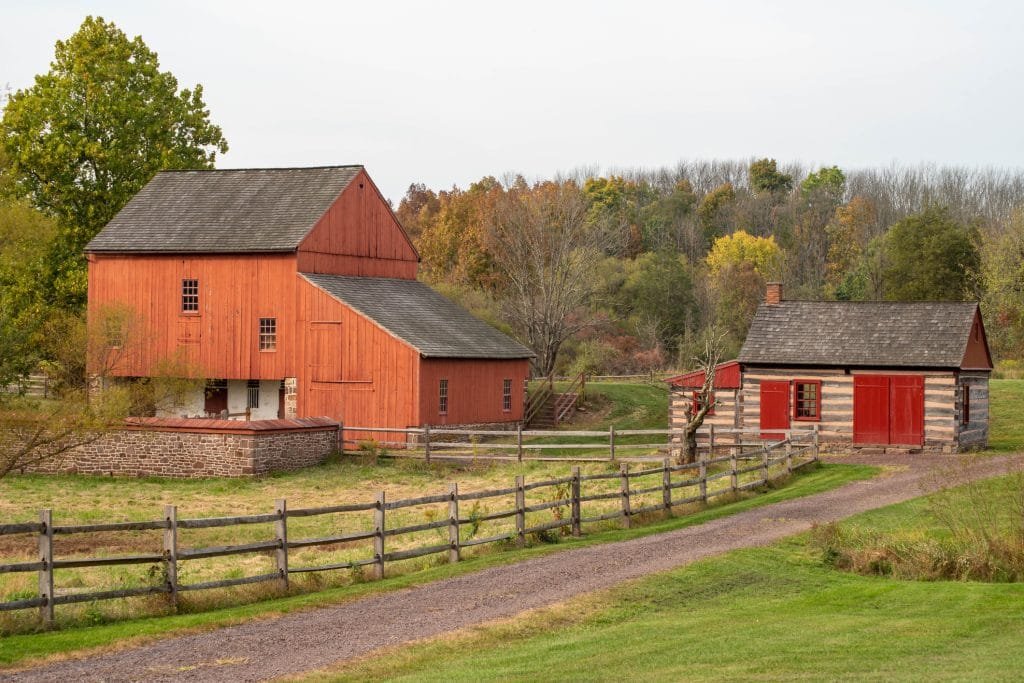This post contains affiliate links.
A barn is essential on any homestead or farm. It can house multiple animals, store feeds and hay supplies. Deciding on where to put your barn is critical. You do not want to have a long journey every time you go to the barn but having it too close is also undesirable.
It is recommended to place your barn 75 feet (23 meters) from your home. The distance between your barn and house may be regulated by local municipal laws with development codes related to barn siting. The barn’s positioning will be influenced by the landscape, wind direction, other practical considerations.
Barns are valuable structures that can perform multiple functions and need to be perfectly situated in relation to the home. There are many factors that influence where you build your barn.

Is There A Set Distance Between The Barn And The House?
There is no set distance between a home and a barn. Some individuals recommend 75 feet ( 23 meters). They note that it could be closer on a small property or further away on a large property.
The better answer is to take all the factors into consideration before building your barn. Each person’s circumstance and use of their barn is unique. As a result, each person should make the best decision for themselves and their family.
What is Included in Barn Siting Zoning Regulations?
Zoning regulations are controlled by development codes that stipulate the parameters of barn siting. These will differ between counties and municipalities, so it is best to enquire from your local building office before planning your barn.
Some aspects which may be governed include:
- Distance from the residential home.
- Distance from the road and property lines.
- Distance from neighbors.
- Access from the road with regard to the entrance of emergency vehicles such as fire engines.
If you live in a community governed neighborhood, there may be restrictions and stipulations on barn design and other barn features.
The Barn Use Influences How Far It Is From The House
When considering how far to place your barn from your home, you need to consider how you will utilize your barn.
If you are storing feeds, hay, farming implements, tools, and tractors, there will be no need to consider animal smell. In this case, having the barn near the home is convenient and the only issue to be cautious of is the potential fire hazard.
If your barn houses horses or cows that have a relatively minimal smell but still attract flies, you should choose to have the barn further away than if it were just a storage barn. At the same time, cows and horses often need care at night if they are sick and so having a barn that is a long walk away from the house is not a sensible idea.
Barns that house animals with strong odors such as chickens and pigs should be situated a fair distance from the house but must still be easily accessible. Animals must be fed and cared for in all weathers, and struggling through bad weather to get to your barn is not fun.

The Effect of Prevailing Winds on Barn Siting?
It is imperative to consider the prevailing wind in your area. This will play a significant role in determining where you site the barn and your home. Winds in a region regularly blow from one direction, known as the prevailing wind.
It is not to say that wind never blows from another direction. There will be a predominant pattern in airflow that is influenced by geographical formations and atmospheric pressure. This is the wind that must be considered.
The barn should be placed in a direction where odors, flies, and other pests are blown away from the home. In this way, you can have the barn relatively close to the house without having to endure animal smells and flies.
You also want to locate the barn so the doors are not in line with the prevailing wind direction. If the barn doors are facing the direction of the wind it could create a wind tunnel effect in your barn. It is better to place the barn on a small angle to the predominant wind direction so good ventilation occurs but not a wind tunnel.
Learn more about what direction a barn should face in my article, Which Direction Should A Barn Face? Tips to Consider.
How Climate Affects the Distance Between the Barn and Home
Temperate climates are easy places to live. You can place your barn whatever distance you choose from your home without having to take the weather into account.
If you live in areas with significant snowfall and cold weather, you will want to have a short distance between the house and the barn. Shoveling snow for long distances every day can be tiring and make life difficult when animals must be fed twice a day.
Regions with regular torrential rain should also have shorter distances between the house and the barn. But picking a location with adequate drainage is also imperative.
- Tim Bodamer (Author)
- English (Publication Language)
- 194 Pages - 09/04/2021 (Publication Date) - Atlantic Publishing Group Inc (Publisher)
Landscape Considerations For Barn Siting
The land formations and contours can affect how far the barn is situated from the home. No one wants to walk around or over a hill to reach their barn. It would make more sense to have both on the same side of the mountain.
Some rural homes have spectacular views, which is important to the homeowner. Barns should not be situated where they obstruct views or influence the aesthetics of the house.
If the home is situated on a slope, careful thought must be given to where the barn should be built. Constantly walking uphill either to the barn or house can be tiring after a long day – unless you plan to use it as a daily exercise regime.
You will also want to place your barn on level ground and in an area where water will drain away from the building. This may affect how close or far your barn is from your house depending on the landscape.
Barns Must-Have Easy Access For Large Trucks And Trailers
A barn built too close to a house may have limited access for large vehicles delivering feed or hay. It is important to remember the aspect of access when situating barns. It can be unpleasant and disturbing for the occupants of the home to have large vehicles rolling past on the way to the barn. In addition, large vehicles may damage the garden plants and lawns.
Final Thoughts
There is no perfect number for the distance between the house and barn on a farm or homestead. Each person must consider the factors relevant to their land and circumstances to make the best choice for themselves. Municipal or county legal requirements must be adhered to.
Picking a location that is neither too close nor too far as well as no obstacles, has a level surface and good drainage are the most important aspects of siting a barm. The decision is best made on an individual basis.

